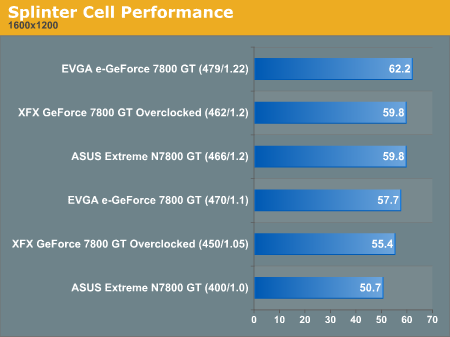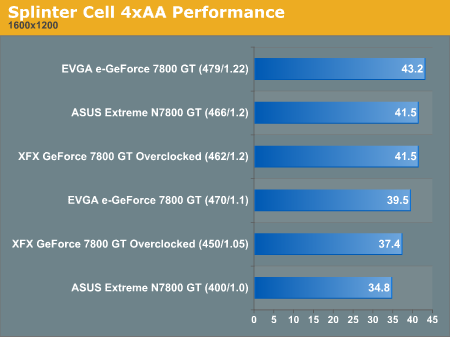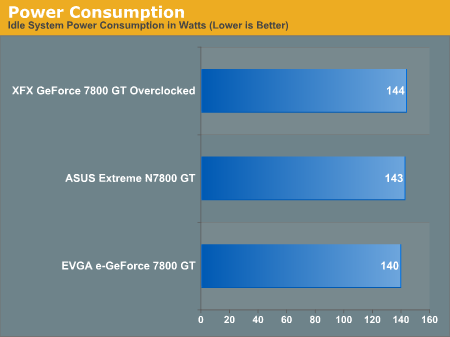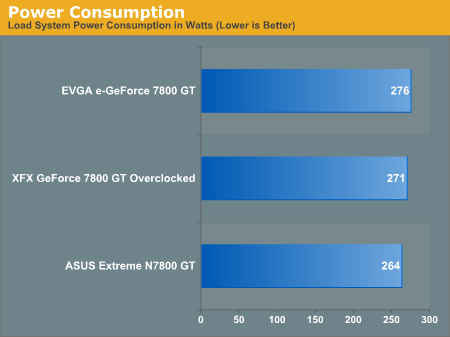Overclocking/Power Load
We've overclocked a few 7800 GTs in the past, with positive results, and we put each of these three cards to the test for this review. It is important for us to note here that overclocking any graphics card over the factory clock can be hazardous to the card, and also, the results of these tests are subjective. Many times, two cards of the exact same brand and model will have different results when overclocking, but these tests are to give us a general idea of each card's overclocking abilities.
Something that we want to touch on briefly is the issue of scaling frequencies for the 7800, which we first saw when overclocking the 7800 GTX. To recap, because of the way clock frequencies scale for the 7800 GT and GTX, increases in core clock speeds don't always represent actual increases in performance. There are "plateaus" where several consecutive clock speeds (i.e. 468, 469, 470MHz) yield nearly exactly the same performance, and then we see a sudden step up in performance between certain frequencies (i.e. 477MHz, 478MHz ) to create a "stair-like" graph when visualizing the performance scaling. You can take a look at a similar graph and some information about this from a past article here.
To give you an idea of how we overclock our cards beyond their factory speeds, we first use coolbits to detect optimal settings for each card. Then we loop some benchmarks, and lower the clock speeds if we see any graphical tearing or artifacts. A good thing about NVIDIA's overclocking tool is that it will keep the card fairly safe from damage caused by attempting to overclock it too high. We simply use trial and error, raising or lowering the core and memory clock speeds until we find settings that offer the maximum performance while running the tests completely stable.
When we overclocked the ASUS EN7800 GT, which is clocked at reference speeds (400MHz/1.0GHz), we find that it clocks up to 468MHz core and 1.2GHz memory. The XFX 7800 GT OC overclocked to 462MHz and 1.2GHz, not much higher than its own factory overclock. The EVGA e-GeForce 7800 GT had a fairly high overclock, considering that it already came factory OC'ed pretty high: 479MHz core and 1.22GHz memory clock. We ran some Splinter Cell benchmarks to see what kind of framerates would result at the different clock speeds, and here they are for your reference.
To test the power load of the card, we measure the total watt usage of our test computer at the wall outlet, recording the power usage of our system in two different states. The first state is with the card installed and the computer is idle, and the second is during intensive performance tests (looped Splinter Cell benchmarks). This way, we are able to get a general idea of how the power usage varies between cards.
We've overclocked a few 7800 GTs in the past, with positive results, and we put each of these three cards to the test for this review. It is important for us to note here that overclocking any graphics card over the factory clock can be hazardous to the card, and also, the results of these tests are subjective. Many times, two cards of the exact same brand and model will have different results when overclocking, but these tests are to give us a general idea of each card's overclocking abilities.
Something that we want to touch on briefly is the issue of scaling frequencies for the 7800, which we first saw when overclocking the 7800 GTX. To recap, because of the way clock frequencies scale for the 7800 GT and GTX, increases in core clock speeds don't always represent actual increases in performance. There are "plateaus" where several consecutive clock speeds (i.e. 468, 469, 470MHz) yield nearly exactly the same performance, and then we see a sudden step up in performance between certain frequencies (i.e. 477MHz, 478MHz ) to create a "stair-like" graph when visualizing the performance scaling. You can take a look at a similar graph and some information about this from a past article here.
To give you an idea of how we overclock our cards beyond their factory speeds, we first use coolbits to detect optimal settings for each card. Then we loop some benchmarks, and lower the clock speeds if we see any graphical tearing or artifacts. A good thing about NVIDIA's overclocking tool is that it will keep the card fairly safe from damage caused by attempting to overclock it too high. We simply use trial and error, raising or lowering the core and memory clock speeds until we find settings that offer the maximum performance while running the tests completely stable.
When we overclocked the ASUS EN7800 GT, which is clocked at reference speeds (400MHz/1.0GHz), we find that it clocks up to 468MHz core and 1.2GHz memory. The XFX 7800 GT OC overclocked to 462MHz and 1.2GHz, not much higher than its own factory overclock. The EVGA e-GeForce 7800 GT had a fairly high overclock, considering that it already came factory OC'ed pretty high: 479MHz core and 1.22GHz memory clock. We ran some Splinter Cell benchmarks to see what kind of framerates would result at the different clock speeds, and here they are for your reference.


To test the power load of the card, we measure the total watt usage of our test computer at the wall outlet, recording the power usage of our system in two different states. The first state is with the card installed and the computer is idle, and the second is during intensive performance tests (looped Splinter Cell benchmarks). This way, we are able to get a general idea of how the power usage varies between cards.












33 Comments
View All Comments
MadAd - Tuesday, December 13, 2005 - link
Still no word on the comparitive fan noise?semiconductorslave - Tuesday, December 13, 2005 - link
If you look in the GTX 512 Mb review here:http://www.anandtech.com/video/showdoc.aspx?i=2607...">7800 GTX 512MB
you see in Battlefield2 1600 x 1200 with 4xaa the stock 7800GTX is getting 42.9 fps compared to this article where the EVGA gets 43.6 fps! Also the GT was running on a FX-55 2.6GHz and the GTX was on a FX-57 (2.8GHz)
I own this card and think its a great value, to be able to come so close to and even sometimes outperform the GTX at $450. I can't wait to add card #2.
I didn't see what drivers were used in this review, but the other review used nForce4 6.82. Also this review showed 1 Gb of ram, other review doesn't mention ammount of ram used. Am I the only one who looks between diferent benchmarks to compare, would be great to see more comparisons (graphics cards) on same test bed, like the other posts mentioned. That way you can really show what value the cards are.
jiulemoigt - Friday, December 9, 2005 - link
there was only 2000 asus led version cards made most went to review sites. I was looking back when they came out I even called and got the model number and a second internal number found out only 2000 were made kinda like a paper launch... and all the sites say this is a sweet looking card, yet 90% of the people reading the reviews will end up with a boarding green pcp... so I bought a bfg and used nonconditive uv paint to paint it bright green. But review sites should point out that people will not get a cool looking slow card from asus with crappy warrenty compared to bfg, xfx, evga.yacoub - Friday, December 9, 2005 - link
Up to what level of temperature (Celcius) is safe for a GPU to maintain without impacting its expected lifespan and performance (ie, lockup/failure)?fbrdphreak - Thursday, December 8, 2005 - link
Discussion thread on this article:http://forums.anandtech.com/messageview.aspx?catid...">http://forums.anandtech.com/messageview.aspx?catid...
Slaimus - Thursday, December 8, 2005 - link
If anyone is shocked by the power usage numbers, remember that the system is using a notoriously inefficient PowerStream. The DC power draw is probably close to 200W, which is how power supplies are rated.segagenesis - Thursday, December 8, 2005 - link
Is that too good to be true... the EVGA is barely over $300 on newegg? I hope I'm not, because I think I just found my new video card.Visual - Thursday, December 8, 2005 - link
you are dreaming, yes. i see two eVGA models on newegg, N515 for $309 (actually 289 after MIR) and N518 for $379. Well guess what, the cheaper variant uses a cheaper aluminium cooler, which doesnt give you much hope for further overclocking :/ None of those two variants are the "CO" edition from this roundup, the CO's clocks are said to be 470/1100, the two models on newegg are clocked 445/1070.this is what i was talking about in my above post... the roundup doesn't really show you the differences between the various cards :/ and i bet other people will make the same mistake as you and confuse one card with another.
still, for the $289 price that card is a bargain. i just want to be sure you realise it's not the same one reviewed here.
segagenesis - Thursday, December 8, 2005 - link
Thanks, yet its still not bad at all for a 7800GT even if its stock. I was under the assumption still that 7800GT cards were still $400 or so.Spacecomber - Thursday, December 8, 2005 - link
Is there any difference in the fan noise generated by these three models?